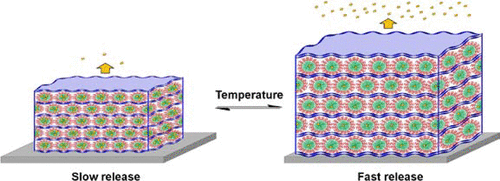当前位置:
X-MOL 学术
›
ACS Appl. Polym. Mater.
›
论文详情
Our official English website, www.x-mol.net, welcomes your
feedback! (Note: you will need to create a separate account there.)
Temperature-Responsive Multilayer Films of Micelle-Based Composites for Controlled Release of a Third-Generation EGFR Inhibitor
ACS Applied Polymer Materials ( IF 4.4 ) Pub Date : 2020-01-28 , DOI: 10.1021/acsapm.9b01051 Li Xu 1 , Hailong Wang 1 , Zihan Chu 1 , Lawrence Cai 1 , Haifeng Shi 1 , Chunyin Zhu 1 , Donghui Pan 2 , Jia Pan 3 , Xiang Fei 4 , Yabin Lei 1
ACS Applied Polymer Materials ( IF 4.4 ) Pub Date : 2020-01-28 , DOI: 10.1021/acsapm.9b01051 Li Xu 1 , Hailong Wang 1 , Zihan Chu 1 , Lawrence Cai 1 , Haifeng Shi 1 , Chunyin Zhu 1 , Donghui Pan 2 , Jia Pan 3 , Xiang Fei 4 , Yabin Lei 1
Affiliation

|
Lung cancer is a complicated long-term disease, which is extremely difficult to cure. A traditional single drug delivery system cannot achieve desired long-term controlled release of therapeutic compounds. Our previous studies have found that temperature-responsive micelles demonstrated high loading efficiency and a long-term controlled release rate, which allows them to be an efficient drug delivery system. We utilized temperature-responsive micelles and hyaluronic acid biopolymers to create a sandwich-like membrane based on hydrogen bonding by layer-by-layer (LBL) self-assembly technology. The multilayer films efficiently absorbed osimertinib—the third-generation inhibitor for nonsmall cell lung cancer (NSCLC) treatment. The release profile of osimertinib from the films is controlled by environmental stimuli. Block copolymer micelles with a poly(N-isopropylacrylamide) (PNIPAM) core were deposited into the multilayer films to introduce temperature sensitivity to the composite thin films. By the above approach, we built a drug carrier for the delivery of an anticancer drug, which potentially demonstrates good loading capacity, high morphology stability, and a controllable drug release mode. We investigated the films’ responsive behavior to temperature and ionic strength and loading capacity of the composite membrane and explored the influence of each component on the response of the drug release profile to environmental triggers. The films retained their morphology integrity after several temperature-triggered swelling/deswelling cycles based on atomic force microscopy and ellipsometry measurements. The mechanism of the intermolecular interaction and molecular motions in the system was studied to elucidate the relationship between structure and delivering efficiency of the system. Development of the LBL films can provide ideas for the modification of traditional drug delivery materials. More importantly, nanoparticle layer-by-layer self-assembly and micro/nanoscale structure manipulation for controlled release of therapeutic compounds are also beneficial to future design and development of innovative functional materials.
中文翻译:

胶束基复合材料的温度响应性多层膜,用于第三代EGFR抑制剂的控制释放
肺癌是一种复杂的长期疾病,很难治愈。传统的单一药物递送系统无法实现治疗化合物的所需长期控释。我们以前的研究发现,温度响应性胶束具有较高的负载效率和长期控释率,这使其成为一种有效的药物递送系统。我们利用温度响应性胶束和透明质酸生物聚合物,通过逐层(LBL)自组装技术基于氢键形成了三明治状的膜。多层膜有效吸收了奥西替尼(第三代非小细胞肺癌(NSCLC)治疗抑制剂)。奥西替尼从薄膜中的释放曲线受环境刺激的控制。带有聚(ñ-异丙基丙烯酰胺(PNIPAM)核心被沉积到多层膜中,以提高复合薄膜的温度敏感性。通过以上方法,我们构建了用于递送抗癌药物的药物载体,该药物载体可能显示出良好的负载能力,高形态稳定性和可控的药物释放模式。我们研究了膜对温度,离子强度和复合膜负载能力的响应行为,并探讨了每种成分对药物释放曲线对环境触发响应的影响。在基于原子力显微镜和椭偏测量的几个温度触发的溶胀/溶胀循环后,这些膜保持了其形态完整性。研究了系统中分子间相互作用和分子运动的机理,以阐明系统结构与传递效率之间的关系。LBL薄膜的开发可以为传统药物输送材料的改良提供思路。更重要的是,用于控制性释放化合物的纳米粒子逐层自组装和微米/纳米级结构操纵也有利于创新功能材料的未来设计和开发。
更新日期:2020-01-29
中文翻译:

胶束基复合材料的温度响应性多层膜,用于第三代EGFR抑制剂的控制释放
肺癌是一种复杂的长期疾病,很难治愈。传统的单一药物递送系统无法实现治疗化合物的所需长期控释。我们以前的研究发现,温度响应性胶束具有较高的负载效率和长期控释率,这使其成为一种有效的药物递送系统。我们利用温度响应性胶束和透明质酸生物聚合物,通过逐层(LBL)自组装技术基于氢键形成了三明治状的膜。多层膜有效吸收了奥西替尼(第三代非小细胞肺癌(NSCLC)治疗抑制剂)。奥西替尼从薄膜中的释放曲线受环境刺激的控制。带有聚(ñ-异丙基丙烯酰胺(PNIPAM)核心被沉积到多层膜中,以提高复合薄膜的温度敏感性。通过以上方法,我们构建了用于递送抗癌药物的药物载体,该药物载体可能显示出良好的负载能力,高形态稳定性和可控的药物释放模式。我们研究了膜对温度,离子强度和复合膜负载能力的响应行为,并探讨了每种成分对药物释放曲线对环境触发响应的影响。在基于原子力显微镜和椭偏测量的几个温度触发的溶胀/溶胀循环后,这些膜保持了其形态完整性。研究了系统中分子间相互作用和分子运动的机理,以阐明系统结构与传递效率之间的关系。LBL薄膜的开发可以为传统药物输送材料的改良提供思路。更重要的是,用于控制性释放化合物的纳米粒子逐层自组装和微米/纳米级结构操纵也有利于创新功能材料的未来设计和开发。











































 京公网安备 11010802027423号
京公网安备 11010802027423号